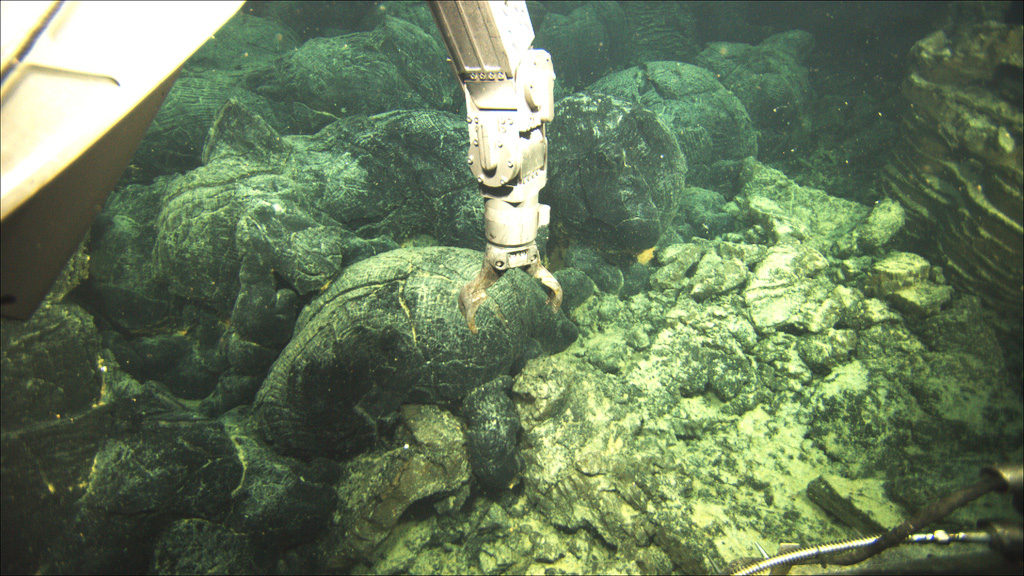Skidaway Institute of Oceanography scientist Aron Stubbins joined a research cruise this summer to study hydrothermal vents, but what his fellow scientists found was a recently erupted undersea volcano.
The Axial Seamount is an undersea volcano located about 250 miles off the Oregon coast and is one of the most active and intensely studied seamounts in the world. What makes the event so intriguing is that Bill Chadwick, an Oregon State University geologist, and Scott Nooner, of Columbia University, had forecast the eruption five years before it happened. Their forecast, published in the Journal of Volcanology and Geothermal Research, was based on a series of seafloor pressure measurements that indicated the volcano was inflating and is the first successful forecast of an undersea volcano.
The discovery of the new eruption came on July 28, when Chadwick, Nooner and their colleagues led an expedition to Axial aboard the R/V Atlantis, operated by the Woods Hole Oceanographic Institution. Using “Jason,” a remotely operated robotic vehicle (ROV), they discovered a new lava flow on the seafloor that was not present a year ago. The expedition was funded by the National Science Foundation and the National Oceanic and Atmospheric Administration (NOAA).
“When eruptions like this occur, a huge amount of heat comes out of the seafloor, the chemistry of seafloor hot springs is changed, and pre-existing vent biological communities are destroyed and new ones form,” Chadwick said. “Some species are only found right after eruptions, so it is a unique opportunity to study them.”
Stubbins was on the cruise to study the dissolved organic matter being released from the hydrothermal vents in the ocean floor with Pamela Rossel from the Max Planck Institute Marine Geochemistry group in Oldenburg, Germany, and David Butterfield from the NOAA Vents program. Funding for Stubbins and Rossel was provided by the Hanse-Wissenschaftskolleg (www.h-w-k.de) and Max Planck Institute, both in Germany.
“The material from the vents reaches over 300 degrees centigrade,” Stubbins said.
At that temperature, the heat modifies the dissolved organic matter, altering its chemistry and reactivity, and therefore, its fate in the water column.
“These ecosystems are amazing,” Stubbins continued. “They include large worms, snails, fish and shrimp that live thousands of meters below the ocean. All this life is fueled, not by the sun, but by chemicals released from the vents”

The manipulator arm of the ROV Jason prepares to sample the new lava flow that erupted in April 2011 at Axial Seamount, located off the Oregon coast. (photo courtesy of Bill Chadwick, Oregon State University; copyright Woods Hole Oceanographic Institution)
Immediately after an eruption the whole system is in flux, continued Stubbins. Vents in the ocean floor called snow blower vents produce streams of white particles, creating a snow globe effect. These snow blowers are only short lived.
“Getting samples from these ephemeral systems provided us with a novel opportunity to gain new insight into these deep sea ecosystems” said Stubbins.
For Chadwick and Nooner the eruption was vindication for years of hard work. “The acid test in science – whether or not you understand a process in nature – is to try to predict what will happen based on your observations,” Chadwick said. “We have done this and it is extremely satisfying”
For Stubbins and Rossel, the journey of discovery is just beginning. “Nobody knows how much carbon is pumped into the ocean by these snow blowers or the other vents associated with the eruption” Stubbins said. The good fortune of sampling right after a major eruption has provided a unique opportunity to find out.



